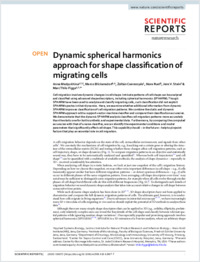Dynamic spherical harmonics approach for shape classification of migrating cells
- Medyukhina, Anna Applied Systems Biology, Leibniz Institute for Natural Product Research and Infection Biology – Hans Knöll Institute (HKI), Jena, Germany - Center for Bioimage Informatics, St. Jude Children’s Research Hospital, Memphis, TN, USA
- Blickensdorf, Marco Applied Systems Biology, Leibniz Institute for Natural Product Research and Infection Biology – Hans Knöll Institute (HKI), Jena, Germany
- Cseresnyés, Zoltán Applied Systems Biology, Leibniz Institute for Natural Product Research and Infection Biology – Hans Knöll Institute (HKI), Jena, Germany
- Ruef, Nora Department of Oncology, Microbiology and Immunology, University of Fribourg, Fribourg, Switzerland
- Stein, Jens V. Department of Oncology, Microbiology and Immunology, University of Fribourg, Fribourg, Switzerland
- Figge, Marc Thilo Applied Systems Biology, Leibniz Institute for Natural Product Research and Infection Biology – Hans Knöll Institute (HKI), Jena, Germany - Institute of Microbiology, Faculty of Biological Sciences, Friedrich Schiller University Jena, Jena, Germany - Center for Sepsis Control and Care (CSCC), Jena University Hospital, Jena, Germany
-
08.04.2020
Published in:
- Scientific Reports. - 2020, vol. 10, no. 1, p. 6072
English
Cell migration involves dynamic changes in cell shape. Intricate patterns of cell shape can be analyzed and classified using advanced shape descriptors, including spherical harmonics (SPHARM). Though SPHARM have been used to analyze and classify migrating cells, such classification did not exploit SPHARM spectra in their dynamics. Here, we examine whether additional information from dynamic SPHARM improves classification of cell migration patterns. We combine the static and dynamic SPHARM approach with a support-vector-machine classifier and compare their classification accuracies. We demonstrate that the dynamic SPHARM analysis classifies cell migration patterns more accurately than the static one for both synthetic and experimental data. Furthermore, by comparing the computed accuracies with that of a naive classifier, we can identify the experimental conditions and model parameters that significantly affect cell shape. This capability should – in the future – help to pinpoint factors that play an essential role in cell migration.
- Faculty
- Faculté des sciences et de médecine
- Department
- Département de Médecine
- Language
-
- English
- Classification
- Biological sciences
- Other electronic version
- License
- License undefined
- Identifiers
-
- RERO DOC 328933
- DOI 10.1038/s41598-020-62997-7
- Persistent URL
- https://folia.unifr.ch/unifr/documents/308745
Other files
Statistics
Document views: 126
File downloads:
- ste_dsh.pdf: 156
- ste_dsh_sm.pdf: 103

